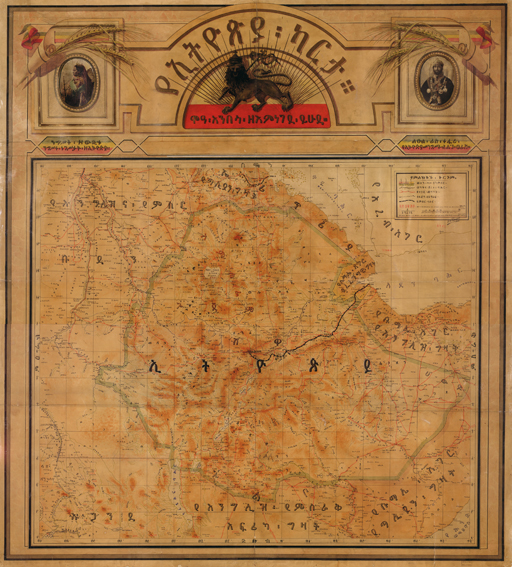La carte manuscrite de Papazian / Papazian’s hand drawn map
8 décembre 2012En 1924, alors qu’il est de passage à Addis Abeba, le Dr Homer L Shantz, géographe américain, auteur avec Charles F Marbut d’un monumental traité sur la végétation de l’Afrique, est invité à dîner au palais du prince régent Tafari Makonnen. Traversant un salon, il dit son admiration devant une large carte manuscrite suspendue au mur. Magnifiquement colorée – les variations du relief sont traduites dans une gamme de tons ocres – la carte, rédigée en amharique, indique les rivières, les lacs et les montagnes, les villes et les villages d’Éthiopie, mais aussi les routes, les frontières et le tracé du chemin de fer. Elle porte la signature, sous les légendes, de Kh B Papazian, géographe à la cour, ainsi que la date de 1923. Dans le quart supérieur plus richement orné, les portraits de l’impératrice Zaouditou et du jeune ras Tafari – deux photographies coloriées à la main – figurent dans deux médaillons ovales, de chaque côté du Lion d’Éthiopie, lequel porte sur son épaule droite la Croix chrétienne. Sous le dessin du Lion, on lit la devise des monarques éthiopiens : « Il a remporté la victoire, le lion de la Tribu de Juda. » D’un geste de la main, le prince ordonne qu’on décroche la carte et qu’on la donne à l’Américain. Celui-ci ignorait qu’en ces lieux, admirer c’est désirer. Selon Habte M Teclemariam, Senior Reference Librarian à la Bibliothèque du Congrès de Washington, la présence d’un portrait de Tafari dans un médaillon placé à égalité avec celui de Zaouditou avait servi à légitimer le fait que le ras exerçât l’autorité de paire avec l’impératrice, en fait dépossédée de presque tout pouvoir. Tafari pouvait donc bien se défaire de cette carte dont le savant américain fit don à son tour à la Bibliothèque du Congrès. En 1954, à l’occasion d’une visite aux États-Unis d’Amérique, Sa Majesté Impériale Haïlé Sélassié Ier revit cette carte exposée à Washington. Il se serait alors souvenu avec amusement de son geste, trente ans plus tôt.

La carte manuscrite de Papazian / Papazian’s hand drawn map.
Library of Congress, Washington DC, USA.
Papazian’s hand drawn map — In 1924, as he is passing through Addis Ababa, the Dr Homer L Shantz, an American geographer, the author with Charles F Marbut of a monumental treatise on African vegetation, is invited to have dinner at the palace of the prince regent Tafari Mekonnen. Walking through a lobby, he voices his admiration for a large hand drawn map hanging on the wall. Magnificently coloured – the variations of landscape relief are rendered in a scale of ochre tones – the map, annotated in Amharic, indicates the rivers, lakes and mountains, the towns and villages of Ethiopia, but also the roads, the borders and the outline of the railroad. It bears the signature, underneath the captions, of Kh B Papazian, court geographer, and the date of 1923. In the more richly decorated top quarter, the portraits of the empress Zawditu and of the young ras Tafari – two hand coloured photographs – feature inside two oval medallions, on either side of the Lion of Ethiopia, carrying on his right shoulder the Christian Cross. Under the figure of the Lion, is transcribed the motto of the Ethiopian monarchs: the Lion of the Tribe of Judah hath conquered. With a flourish of his hand, the prince commands the map to be taken down and given to the American. Little did the latter know that in these realms, to admire is to desire. According to Habte M Teclemariam, Senior Reference Librarian at the Library of Congress in Washington, the presence of a portrait of Tafari inside a medallion placed on an equal footing with Zawditu, had served to legitimize the fact that the ras detained as much authority as the empress, in reality dispossessed of all power. Tafari could easily therefore divest himself of this map which the American scientist in turn gave to the Congress Library. In 1954, upon the occasion of a visit to the United States, His Imperial Majesty Haile Selassie I saw the map again, exhibited in Washington. It seems he then recollected with amusement his gesture of thirty years back.